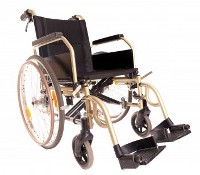In the long-term care resident’s shoes—or wheelchair
It’s one thing to intellectually understand the physical, social and emotional challenges your residents face in long-term care. It’s another to personally experience, even for a very brief time, what they go through on a day-to-day basis. It’s eye opening, that’s for sure, and may just change the way you and your organization treat those entrusted to your care.
I found myself in such a situation recently, when a healthcare issue required brief hospitalization. By the time we reach middle age, most have dealt with the myriad indignities that accompany the acute care experience. Unless you have fame, wealth or connections, you’re just another “account” in the system. (I actually heard a patient referred to this way.)
 In my case, it was a simple transfer from hospital room to the X-ray department that sent me into an existential funk. An orderly suddenly appeared in my doorway one morning with a wheelchair and—being the accommodating, polite (and naïve) patient I was—I quickly moved to the chair without thinking to throw on a robe over my skimpy institutional gown or comb my mussed hair. Little did I know that I would be wheeled through what seemed like miles of public corridors and a bustling lobby.
In my case, it was a simple transfer from hospital room to the X-ray department that sent me into an existential funk. An orderly suddenly appeared in my doorway one morning with a wheelchair and—being the accommodating, polite (and naïve) patient I was—I quickly moved to the chair without thinking to throw on a robe over my skimpy institutional gown or comb my mussed hair. Little did I know that I would be wheeled through what seemed like miles of public corridors and a bustling lobby.
Any sense of dignity and identity flew out the window as the silent orderly pushed me along. A feeling of dependence, infirmity and weakness washed over me as people passed by, glancing down at the poor invalid with what felt like pity and relief not to be me. Upon arrival at the X-ray department, I was parked in the hallway and left to wait … and wait. Doctors and clinicians rushed past, busy and important. I thought to myself, “Hey, I’m a professional, too. I have a busy, important job. I even write about your industry!” Then I caught my reflection in a window and saw just another patient—in this case with unkempt hair, ugly gown and scruffy socks—and shrank deeper into my confining chair.
Finally, the clinician came to collect me and, while he questioned me about my situation, towered over me authoritatively. He wasn’t impolite or patronizing in the least but I sure felt submissive and inferior sitting in that low chair, staring up at him like a child addressing a parent. Then it hit me: This is what so many LTC residents must experience in their daily lives.
I know that I will never again stand over anyone confined to a wheelchair or bed. I will kneel or sit at their level and look them evenly in their eyes. It’s such a small gesture, but as I found, very impactful.
There are educational programs available to healthcare providers that offer them a chance to live a day or more in the life of a LTC resident. My sister, an executive with a commercial development company, which at one time included nursing homes in its portfolio, participated in such a program. It was years ago, but I still remember the frustration she felt trying to communicate and move around with Vaseline-smeared glasses, heavy gloves and ears plugged with cotton, the better to empathize with a resident’s physical challenges.
It’s a revelatory experience and one that LTC administrators might consider providing for their staffs and anyone who interacts with residents on a regular basis.

Patricia Sheehan was Editor in Chief of I Advance Senior Care / Long Term Living from 2010-2013. She is now manager, communications at Nestlé USA.
Related Articles
Topics: Clinical , Facility management











